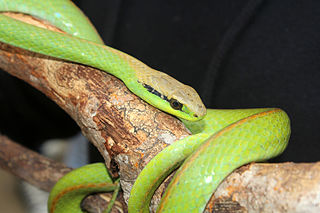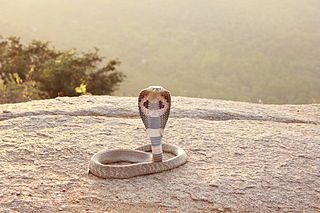
Xenodontinae is a subfamily of snakes in the family Colubridae.

Philodryas olfersii is a species of venomous snake in the family Colubridae. The species is endemic to South America.

Colubroidea is a superfamily of snakes in the clade Colubroides that includes Colubridae, with some studies splitting Colubridae into multiple families that make up Colubroidea. Historically, Colubroidea also included other caenophidian snakes such as cobras and vipers, as these snakes form a clade. However these groups are now divided into several distinct, but related, families. Zaher et al. (2009) proposed to redefine Colubroidea for colubrids and related families, while designating Colubroides as the group containing vipers and cobras as well as colubroids. The ReptileDatabase considers Colubroidea to be composed of Colubridae and the members of its sister group, Elapoidea, and does not recognize the division of Colubridae into multiple families.

Dipsadinae is a large subfamily of colubroid snakes, sometimes referred to as a family (Dipsadidae). Species of the subfamily Dipsadinae are found in most of the Americas, including the West Indies, and are most diverse in South America. There are more than 700 member species.

Thamnodynastes is a genus of snakes of the family Colubridae.

Dryophylax hypoconia is a species of snake in the family Colubridae. The species is endemic to South America.
The false tomodon snake is a genus of snake in the family Colubridae. and is part of the 36 species of the Tachymenini
Dryophylax gambotensis is a species of snake in the family Colubridae. The species is endemic to Colombia.

Dryophylax almae is a species of snake in the family Colubridae. The species is endemic to Brazil.
Dryophylax ceibae is a species of snake in the family Colubridae. The species is endemic to Venezuela.
Dryophylax chaquensis, commonly known as Jararaca-Falsa (Portugese), is a species of snake in the family Colubridae. The species is endemic to Brazil.
Dryophylax chimanta is a species of snake in the family Colubridae. The species is endemic to Venezuela and only known from the Chimantá tepui.

The Colubroides are a clade in the suborder Serpentes (snakes). It contains over 85% of all the extant species of snakes. The largest family is Colubridae, but it also includes at least six other families, at least four of which were once classified as "Colubridae" before molecular phylogenetics helped in understanding their relationships. It has been found to be monophyletic.

The Elapoidea are a superfamily of snakes in the clade Colubroides, traditionally comprising the families Lamprophiidae and Elapidae. Advanced genomic sequence studies, however, have found lamprophiids to be paraphyletic in respect to elapids, and anywhere between four and nine families are now recognized.
Pseudalsophis thomasi, or Thomas' racer, a species of snake in the family Colubridae. It is endemic to several islands in the Galápagos group.
Apostolepis gaboi, also known commonly as the sand dunes blackhead and the cobra-rainha das dunas in Brazilian Portuguese, is a species of snake in the family Colubridae. The species is endemic to Brazil.
Dryophylax dixoni is a species of snake in the family Colubridae. The species is endemic to Venezuela and Colombia.
Dryophylax marahuaquensis is a species of snake in the family Colubridae. The species is endemic to Venezuela.
Dryophylax ramonriveroi, also called the Guianan coastal house snake, is a species of snake in the family Colubridae. The species is found in Venezuela, Suriname, Guyana, and Brazil.
Dryophylax yavi is a species of snake in the family Colubridae. The species is endemic to Venezuela.








